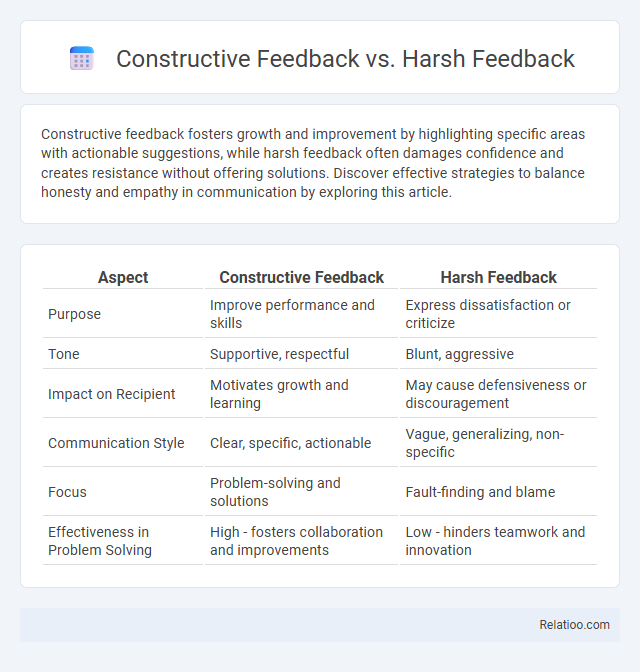Constructive feedback fosters growth and improvement by highlighting specific areas with actionable suggestions, while harsh feedback often damages confidence and creates resistance without offering solutions. Discover effective strategies to balance honesty and empathy in communication by exploring this article.
Table of Comparison
| Aspect | Constructive Feedback | Harsh Feedback |
|---|---|---|
| Purpose | Improve performance and skills | Express dissatisfaction or criticize |
| Tone | Supportive, respectful | Blunt, aggressive |
| Impact on Recipient | Motivates growth and learning | May cause defensiveness or discouragement |
| Communication Style | Clear, specific, actionable | Vague, generalizing, non-specific |
| Focus | Problem-solving and solutions | Fault-finding and blame |
| Effectiveness in Problem Solving | High - fosters collaboration and improvements | Low - hinders teamwork and innovation |
Understanding Constructive Feedback
Understanding constructive feedback involves recognizing it as specific, actionable advice aimed at helping you improve skills or behavior, unlike harsh feedback or harshness that often focuses on criticism without guidance. Constructive feedback emphasizes positive outcomes and growth by addressing issues respectfully and offering solutions, enhancing your personal or professional development. By distinguishing between these approaches, you can better receive and implement feedback that supports learning rather than discouragement.
Defining Harsh Feedback
Harsh feedback refers to criticism delivered with a tone or language that can be perceived as severe, blunt, or unempathetic, often emphasizing faults without supportive guidance. Unlike constructive feedback, which aims to foster growth through specific, actionable suggestions, harsh feedback may discourage or demoralize recipients by focusing solely on negative aspects. Understanding the distinction highlights the importance of balanced communication that promotes improvement while minimizing emotional impact.
Key Differences Between Constructive and Harsh Feedback
Constructive feedback provides specific, actionable suggestions aimed at improving performance while maintaining respect and encouragement, focusing on growth and development. Harsh feedback often emphasizes flaws without guidance, leading to defensiveness and decreased motivation, characterized by a critical tone and lack of support. Your ability to distinguish these types ensures communication that fosters improvement without causing harm or resentment.
Psychological Impact on Recipients
Constructive feedback fosters psychological safety by promoting growth, motivation, and self-efficacy, leading to improved performance and resilience. Harsh feedback triggers stress responses, increasing anxiety and lowering self-esteem, which can hinder learning and reduce productivity. Harshness, characterized by personal attacks or disrespect, causes emotional harm, damages trust, and can result in long-term negative effects such as burnout and decreased workplace engagement.
Effective Communication in Feedback Delivery
Effective communication in feedback delivery hinges on distinguishing constructive feedback, harsh feedback, and outright harshness. Constructive feedback offers specific, actionable insights aimed at improvement and fosters a positive environment, while harsh feedback often emphasizes faults without guidance, risking demotivation. Harshness, characterized by tone and intent, undermines trust and engagement, highlighting the importance of empathy and clarity for impactful feedback.
Benefits of Constructive Feedback in Growth
Constructive feedback fosters personal and professional growth by providing clear, actionable insights that help You improve skills and performance. Unlike harsh feedback or harshness, which can create defensiveness and reduce motivation, constructive feedback encourages a positive learning environment and builds trust. Emphasizing specific behaviors and solutions enables continuous development and long-term success.
Negative Consequences of Harsh Feedback
Harsh feedback often leads to decreased employee motivation, increased stress, and reduced productivity, negatively impacting overall team morale. Unlike constructive feedback, which promotes growth by offering actionable insights, harsh feedback tends to generate fear and resentment, causing communication breakdowns and higher turnover rates. Organizations that prioritize constructive feedback cultivate a positive work environment, whereas harshness fosters hostility and long-term damage to professional relationships.
Best Practices for Giving Constructive Feedback
Effective constructive feedback focuses on specific behaviors and offers actionable suggestions, fostering growth without damaging morale. Unlike harsh feedback or harshness, which often includes personal attacks or vague criticism, constructive feedback prioritizes empathy and clarity to support improvement. You should aim to deliver feedback promptly, balance positive observations with areas for development, and encourage open dialogue to maximize its impact.
Transforming Harsh Critique into Positive Guidance
Transforming harsh critique into positive guidance involves reframing negative comments into actionable insights that foster growth and improvement in your skills or behavior. Constructive feedback emphasizes specific, balanced observations and encourages solutions, while harsh feedback often centers on personal attacks or vague criticism that can hinder motivation. Understanding this distinction helps you embrace feedback as a tool for development rather than a source of discouragement.
Building a Feedback-Driven Culture
Constructive feedback fosters a feedback-driven culture by promoting actionable insights and encouraging growth, whereas harsh feedback often leads to defensiveness and decreased morale. Harshness, characterized by a lack of empathy and negative tone, undermines trust and stifles open communication essential for continuous improvement. Building a culture that emphasizes empathy, clarity, and respect in feedback delivery enhances employee engagement and accelerates organizational learning.

Infographic: Constructive Feedback vs Harsh Feedback
 relatioo.com
relatioo.com